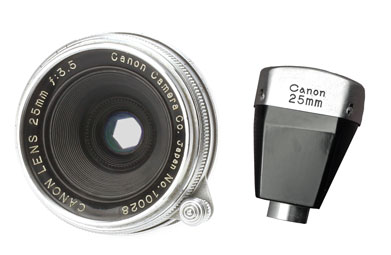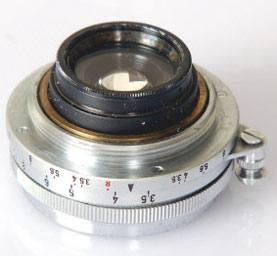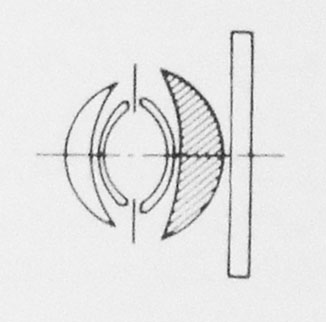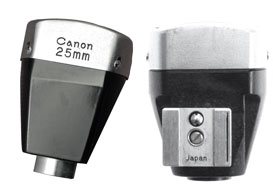Canon Rangefinder 25mm Lenses
A Description of Canon Rangefinder 25mm Lenses 1956-1975

Canon's first ultra-wide angle lens: the Canon 25mm f3.5 of 1956
Development and Introduction of the Canon 25mm f3.5
In 1955 and 1956, Canon was working with new rare earth glasses for their rangefinder lenses. In April 1956 they released the Canon 28mm f2.8. Then, in November 1956, they introduced the Canon 25mm f3.5. The 25mm f3.5 was a lens of five elements in three groups.
As with all Canon products of that era, both the lens and the new 25mm finder were packaged in a fitted leather case.

In January 1957, the Canon rangefinder lens range was re-engineered, and all were mounted in a light alloy body with black focusing ring. The only exception was the 25mm f3.5, which remained in its satin chrome on brass finish. 2
Wide angle lenses for single-lens reflex cameras which most people see today are of a retrofocus design. This allows the rear element of the lens to be far from the film surface, giving room for the camera mirror to swing. In the 1950s, rangefinder cameras did not have this need, and wide angle lenses were of a 'short-focus' design. 12. In the case of the Canon 25mm, the short focus design had a rear element which protruded deeply into the camera body. Also, the lens mounted on the camera body protruded only 16 mm.

rear element of the Canon 25mm f3.5

Canon 25mm Accessory Viewfinder
With the introduction of the Canon VT, an automatic linkage between the camera focus and the accessory viewfinder was created, allowing the accessory viewfinder to correct, automatically, for parallax as the camera was focused. The 25mm f3.5 introduced at this same time, 1956, featured an accessory finder which functioned in this automatic parallax correction system.

Canon 25mm finder with automatic parallax correction linkage.
Canon V-finders, such as this 25mm finder, had an automatic parallax correction linkage to a number of Canon models:
- the Canon VT, VTD
- the Canon L1, L2, L3
- the Canon VL, VL-2
- the Canon VI-L, VI-T
Canon Finder Automatic Parallax Linkage
The Canon cameras listed above had a new feature in the accessory shoe. A pin in the center of the accessory shoe raised and lowered as the rangefinder focus was changed. This pin linked to a series of new V-type Canon accessory finders. The finders would rest on this pin in the accessory shoe and raise and lower, as the pin in the accessory shoe raised and lowered, allowing the finders to automatically automatically for parallax. This was an advanced feature unique to Canon.

the parallax adjustment pin located in the accessory shoe which links to the matching pin in the bottom of the Canon V-type accessory finder
You can click on the links in the table below to consult other pages of the canonrangfinder.org site.
| Navigation: Click Below to Jump to Desired Subject Page | ||
|---|---|---|
| Canon Rangefinder Cameras - 1 | Canon Rangefinder Cameras - 2 | Canon Rangefinder Lenses |
| Canon S | Canon IVSB2 | Canon 19mm |
| Canon J | Canon IIS2, IID2, IIF2 | Canon 25mm |
| Canon NS | Canon VT, Canon L2 | Canon 28mm |
| Canon JS | Canon L1, L3 | Canon 35mm |
| Canon J-II | Canon VT Deluxe | Nikkor 50mm |
| Canon S-II | Canon VL, VL2 | Canon 50mm |
| Canon IIB | Canon VI-L, VI-T | Canon 85mm |
| Canon III, IIC, IV | Canon P | Canon 100mm |
| Canon IIIA, IVF, IVS | Canon 7 | Canon 135mm |
| Canon IIA, IID, IID1 | Canon 7s | Canon 200mm-1000mm |
| Canon IVSB | Minolta Rangefinders | Minolta Lenses |
| Canon IIF, IIS | Other Rangefinders | other M39 lenses |
| Go to canonrangefinder.com home page | ||
Any additions or corrections to these pages would be welcome simply by contacting this site as shown at the foot of this page .
Footnotes:
1 Dechert, Peter. Canon Rangefinder Cameras 1933-1968.
Hove Collectors Books. West Sussex, United Kingdom. 1985. ISBN 0-906447-30-5.
Peter Dechert's book is the most important expert source of information regarding
Canon Rangefinder Cameras.
2 Kitchingman, Peter. Canon M39 Rangefinder Lenses 1939-1971. A Collector's
Guide.
Published by Peter Kitchingman. Perth, Australia. 2008. ISBN 978-0-646-48144-9.
Peter Kitchingman's book is the definitive study of the more than three decades of
M39 format camera lenses developed for Canon Rangefinder Cameras.
3 Nostalgic Canon Camera Book.
懐かしいキヤノン
EI Publishing Co. Ltd. Tokyo, Japan. June 2003.
Peter Kitchingman's book is the definitive study of the more than three decades of
M39 format camera lenses developed for Canon Rangefinder Cameras.
4 "Canon Camera Museum" history website. https://global.canon/en/c-museum/history/
published by Canon, Inc. accessed in 2019.
5 Rajner, Hans P. (author), John Wade (editor). Leica Copies.
Classic Collections Publications. London, UK. ISBN 13: 9781874485056
Hans P. Rajner's book is an excellently detailed and carefully researched study of camera from around
the world which used the Leica M39 lens mount and the same lens to film plane distance.
7 Dechert, Peter. Canon Single Lens Reflex Cameras 1959-1991.
Historical Camera Publications. Yakima, Washington. 1992. ISBN 1-879561-04-2.
8 Tomlinson, Shawn M. The Film Photography Book.
Lulu Pulbications. 2016. ISBN: 9781365263972
9 Sartorius., Ghester. Identifying Leica Lenses. Classic Camera 19.
Tokyo, Japan. 2001. ISBN 4-257-12029-0
10 website http://www.nicovandijk.net/rflensmatrix.htm consulted 2019.
11 O'Reagan, Douglas M. Allied Exploitation of German Science after World War II.
Johns Hopkins University Press. Baltimore, Maryland. 2019. ISBN 9781421428888
12 website www.canonrangefinder.servehttp.com consulted 2008.
13 Minolta expert Andrea Aprà has posted information on
minoltarangefinders group and other groups and further detailed information by email. (thanks Andrea !)
14 website http://www.collection-appareils.fr/objectifs/ consulted 2019.
15 Small, Marc James. Non-Leitz Leica Thread-Mount Lenses.
Wittig Books. Hückelhoven, Germany. 1997. ISBN 3-930359-47-2.
16 the Nikon Corporation website: https://imaging.nikon.com/history/ consulted 2019.
17 p 152. Ray, Sidney F. Photographic Lens ISBN 9780240510323
18 website http://www.rokkorfiles.com/Lens%20History.html accessed 2019
If you have any comments or questions about this Canon Rangefinder site, please e-mail me (Larry Huffman) at e-mail address: [email protected]